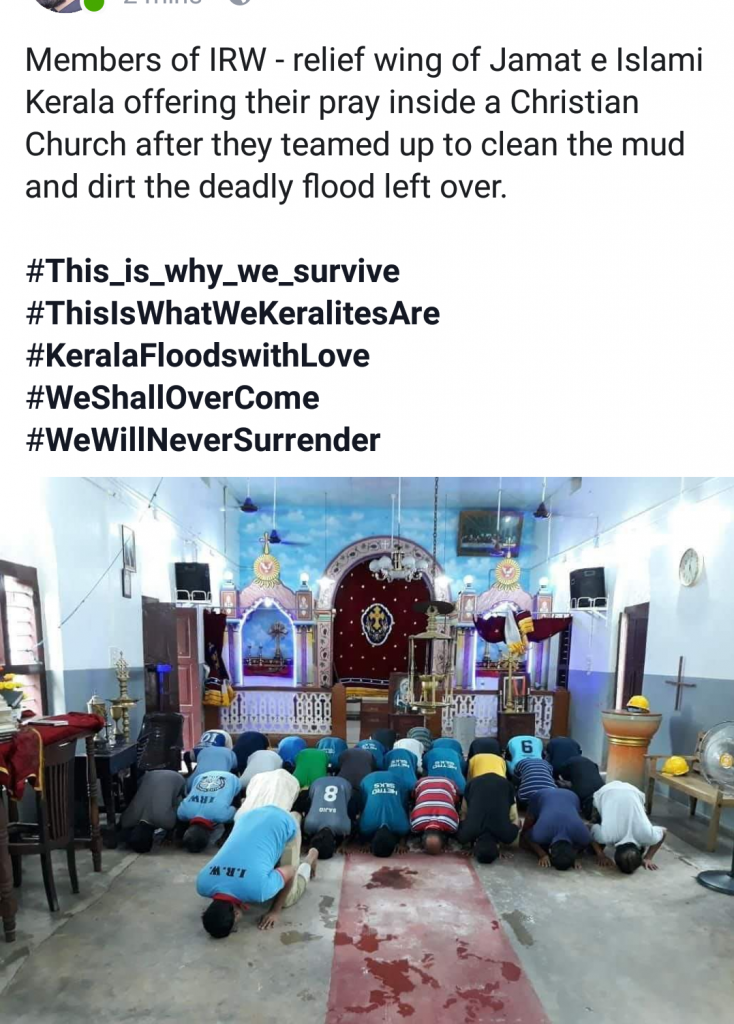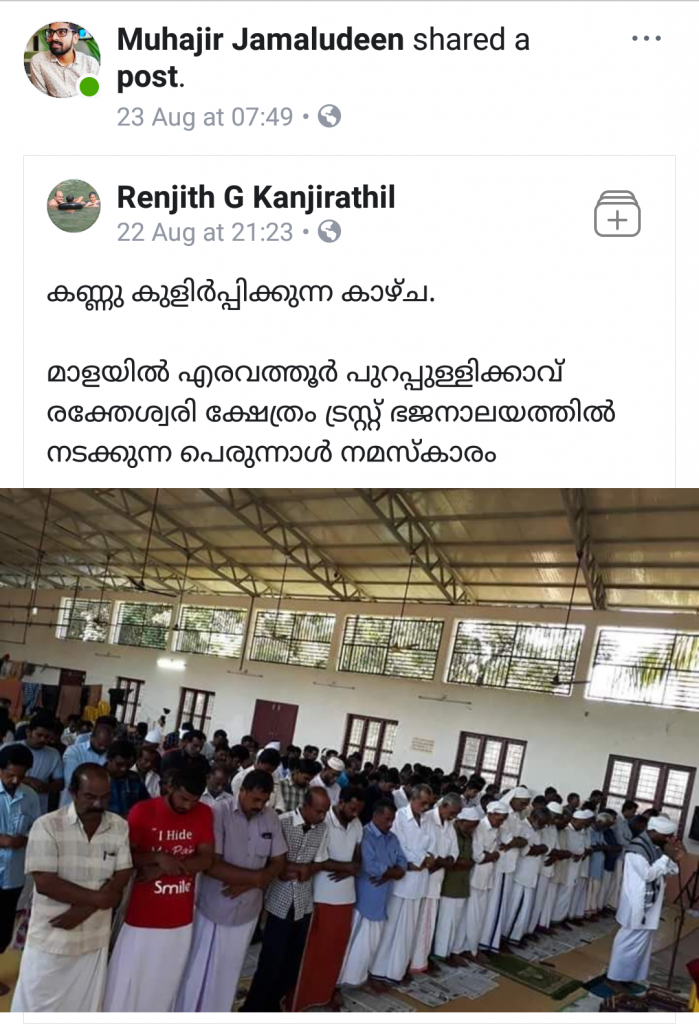
By Najiya O, TwoCircles.net
The heavy downpour in this monsoon season gave way to the worst floods faced by Kerala in a century. Adding to the heavy rains was the ever-increasing water level in the scores of dams all over the state along with landslides and mudslides. The result was the disastrous floods which inundated large parts of the state for days on end. Nearly 400 people lost their lives, thousands were injured. And lakhs were displaced from their homes. But Kerala did not fall down. The small state at the southern end of India fought bravely during the floods and the rescue mission also was successfully completed. And now the state is looking forward to rehabilitation, no, in other words, ‘building the new Kerala’.
The state rose from the initial confusion of the hard-beating floods with a courage and determination unprecedented in history. The rescue of Kerala became the mission of all strata of people, from the fishermen on the coasts to the IT professionals in the cities.
The young generation, which the elders used to laugh at saying they are always on phones and the internet, suddenly rose to the occasion. They utilised the internet on their fingertips to coordinate the rescue mission. Unofficial control rooms opened up on social media such as Whatsapp and Facebook for the rescue mission. Emergency numbers were announced on the social media for the aid of those caught up in the floods. The people stranded on rooftops and isolated buildings in the heavily flooded areas sent audio and video messages on the social media which were widely shared, and thus reached the rescue teams. ‘The Compassionate Kerala’, a group formed by former Kozhikode Collector Prashant Nair (commonly known as Collector Bro among the youths) was at the forefront to coordinate things, by collecting data on the rescue needs, sending information to the rescue teams and updating on the happenings.
The tech-savvy young generation created new apps to aid the rescue mission. The NRIs in the Gulf, Europe and elsewhere coordinated from their respective countries too. The Kerala government also rose to the occasion by creating a new website solely for the rescue and relief activities connected with the deadly floods – www.keralarescue.in. Now, Google could not wait on the sidelines. The internet giant began a move to mark the safety of people. People were asked to mark if they were safe in the Kerala floods or not. Websites like www.microid.in came up with maps to mark the flooded areas, which was useful for both rescue workers as well as those travelling with relief materials.
The leaders of the state-led from the front. They did not give orders and sit back in their comfortable homes. Instead, the ministers, MLAs and other political party leaders were in the front of the mission to save Kerala working from their own respective constituencies. Finance Minister Dr Thomas Isaac and Agriculture Minister VS Sunil Kumar were seen in the forefront of rescue and relief activities. Collector and sub-Collector of Wayanad carried sacks of rice on their backs when trucks came to the relief collection point at night when other volunteers in the camp were taking rest after a tough day. Several district Collectors and IAS officers were in the forefront to lead the rescue and relief mission. Notable are TV Anupama of Thrissur, K Vasuki of Thiruvananthapuram, and Amit Meena of Malappuram, as well as other IAS officers Rajamanickam, UV Sumesh, and Prashant Nair. “You are making history. You are showing the world what Malayalis can do. In my opinion, you are working like soldiers who fought for freedom.” Though these words were said by K Vasuki to a cheering crowd at a relief camp in Thiruvananthapuram, whole Kerala took her words as an inspiration to move forward in the difficult times.
The Chief Minister, who was known to have a difficult relationship with the media, managed the grave situation wisely, with not a single negative tinge in his press meets. He convened press meets regularly and informed the media of what was happening. Even when the whole state was rallying against the centre for not providing an adequate number of army and navy personnel and helicopters for airlifting, the CM maintained that the Centre was helpful and that it had offered more help. He always carried a positive note in his press meets. And his office worked 24×7 in those days.
The bureaucracy worked along with the political leadership, and the local population also joined them. Nobody waited for directions to come from the top as to what to do. The local self-government bodies and its representatives acted as guides of their respective areas to identify and rescue each and every one, and they also supervised the relief camps. Local youth clubs and small groups also played their part in the mission to save the state. They are still active in the field with relief activities in remote areas where the government officials and aid may not reach.
Similarly, the role of the opposition parties also is commendable. The highly-political state of Kerala saw its ruling party and opposition going together in the mission to rescue the people. The opposition stood firmly with the ruling government and kept away from making accusations sensing the gravity of the situation.
The Kerala Police and Fire Force were responsible for the warning and evacuation of people from the affected areas before the waters rose, and they actively involved themselves in the rescue operations once floods came in. They also assisted the central forces and fishermen towards the end. The role of the NDRF, the Indian Army, Navy and Air Force cannot be sidelined; they were in the forefront for rescue by water and air, as well as airdropping food to those stranded in the flooded parts.
Perhaps, the most important part in the rescue mission was carried out by the fishermen. The centre had provided helicopters to airlift those stranded on rooftops in the areas where water had submerged even two-storey houses. Several dams were opened and water was flowing heavily into the 44 rivers all over the state. The rains were incessantly falling too. When Saji Cherian, MLA of Chengannur, broke down on an interview with a news channel, it was clear that things were falling apart. It was then that the new saviours came to the forefront – the fishermen. Fishermen from Thiruvananthapuram, Kollam, Alappuzha and even Malappuram went all the way to the flooded parts with their boats and initiated the new phase of the rescue mission. In fact, they chose on their own volition to risk their lives and row their boats through the heavily-flowing water to save people.
Though the Navy and the NDRF followed in, the death count would have probably gone up substantially, had the fishermen folk not turned up. And the state did recognize the efforts of the sidelined section of the society. Chief Minister Pinarayi Vijayan hailed the fishermen as the ‘Army of Kerala’, which in a way serves as a befitting reply to the centre which refused to send in more army men for the rescue.
Even as the rescue mission was going on, contributions were flowing in from different parts. The government requested people to contribute to the Chief Minister’s Distress Relief Fund. Other states in the country offered great help, financially and materially, which amounts to a total of around Rs 150 crore. When the state announced the primary estimate of loss as Rs 20,000 crore and requested for Rs 2,000 crore as immediate relief, the centre gave Rs 600 crore. Countries like UAE, Qatar and Thailand offered help, but the central government has taken a position not to accept foreign aid.
Tales of love in the time of floods
A fisherman from Tanur in Malappuram district has become the symbol of love and sacrifice in the deadly floods. A group of fishermen saved some women from the floods and boats were ready to transport them to a safer place. But a woman was not well and sensing that she might find it difficult to climb onto the boat from the water in which they were standing, Jaisal did the unexpected. He knelt on the ground covered by water so that the women could step onto his back and get down into the boat. The video of the same went viral on the social media and even the international media took notice of it.
While celebrities and big businessmen are contributing considerable amounts to the Chief Minister’s Distress Relief Fund and relief works of other small groups, there are also tales of love and sacrifice from those who cannot pay much. Malappuram district witnessed one such expression of sacrifice last day when a bunch of old people approached the district Collector and offered their old-age pension amount to the relief fund. Another woman handed over to the Collector the money she had kept for the Umrah pilgrimage. Over 350 inmates from the prisons across the state have been cooking and packing food for the flood victims, to be airdropped or sent to relief camps and stranded houses. They fed the flood-hit people with chapatis, upma, idlis, bread and jam etc.
The volunteers of the Ideal Relief Wing, the disaster management wing of the Jamat-e-Islami Hind were active in the rescue mission in all parts of the state. And now that the rescue has been completed, the IRW is active in running relief camps and in the cleaning of houses, other buildings and public places. There have been reports of the members of the IRW cleaning up a church first and then offering prayers inside the church itself as there were no mosques nearby. Different teams of the IRW have moved to different parts of the states with relief kits comprising of cleaning items, food and essentials etc for the relief activities. The state coordination office of the organization in Kozhikode is managing the activities.

In another example of love and harmony, a temple in Thrissur district opened its doors to the Muslims of the area to offer their Eid prayers since all mosques in their area were covered with water. Another report says of a group of people including women in a village who were shifted to a mosque nearby as the residential area was under the threat of a landslide. Mosques that allow women inside have specific places allotted for them normally. Hindu temples do not normally allow non-Hindus to enter. But all those restrictions flew away as they saw people suffering. Mosques and churches turned into relief camps, temples opened their doors for Eid namaz.

A group of 200 people from Malappuram are at the forefront of cleaning activities in Aluva in Ernakulam district on Saturday. The team under the banner of ‘Mission Flood 2018’ went to Aluva with cleaning equipment, medical facilities, clothes, food and drinking water etc. They cleaned up houses, public places and temples alike. The team also had plumbers and electricians, snake-catchers and doctors for the mission.
There have also been reports of little kids contributing to the flood relief. A little girl who had been saving money to buy a bicycle broke her piggy bank and gave all her money to the CMDRF. On knowing the incident, the famous cycle company Hero Cycles has got ready to gift her a bicycle. In another incident, a brother and sister decided to donate the land they inherited from their father to the CMDRF.

